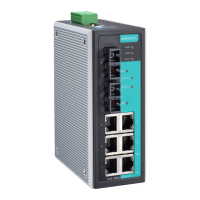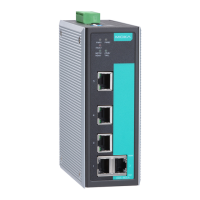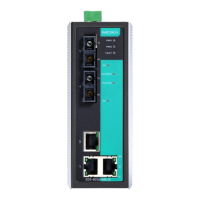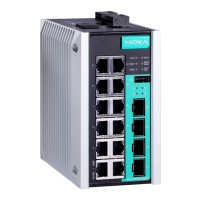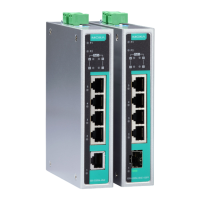Moxa Managed Ethernet Switch (UI_2.0_FW_5.x) User Manual
Link-Swap-Fast-Recovery
Enable/Disable
Select the checkbox to enable the Link-Swap-Fast-Recovery
Enable
Multicast
Multicast f iltering improves the perf ormance of networks that carry multicast traf f ic. This section explains
multicasts, multicast f iltering, and how multicast f iltering can be implemented on your Moxa switch.
The Concept of Multicast Filtering
What is an IP Multicast?
A multicast is a packet sent by one host to multiple hosts. Only those hosts that belong to a specif ic
multicast group will receive the multicast. If the network is set up correctly, a multicast can only be sent to
an end-station or a subset of end-stations on a LAN or VLAN that belong to the multicast group. Multicast
group members can be distributed across multiple subnets, so that multicast transmissions can occur within
a campus LAN or over a WAN. In addition, networks that support IP multicast send only one copy of the
desired information across the network until the delivery path that reaches group members diverges. To
make more efficient use of network bandwidth, it is only at these points that multicast packets are
duplicated and f orwarded. A multicast packet has a multicast group address in the destination address field
of the packet’s IP header.
Benefits of Multicast
The benef its of using IP multicast are:
• It uses the most efficient, sensible method to deliver the same information to many receivers with only
one transmission.
• It reduces the load on the source (for example, a server) since it will not need to produce several copies
of the same data.
• It makes ef f icient use of network bandwidth and scales well as the number of multicast group members
increases.
• Works with other IP protocols and services, such as Quality of Service (QoS).
Multicast transmission makes more sense and is more efficient than unicast transmission for some
applications. For example, multicasts are of ten used f or video-conf erencing, since high volumes of traf f ic
must be sent to several end-stations at the same time, but where broadcasting the traff ic to all end-stations
would cause a substantial reduction in network perf ormance. Furthermore, several industrial automation
protocols, such as Allen-Bradley, EtherNet/IP, Siemens Prof ibus, and Foundation Fieldbus HSE (High Speed
Ethernet), use multicast. These industrial Ethernet protocols use publisher/subscriber communications
models by multicasting packets that could f lood a network with heavy traf f ic. IGMP Snooping is used to
prune multicast traf f ic so that it travels only to those end destinations that require the traf f ic, reducing the
amount of traf f ic on the Ethernet LAN.
